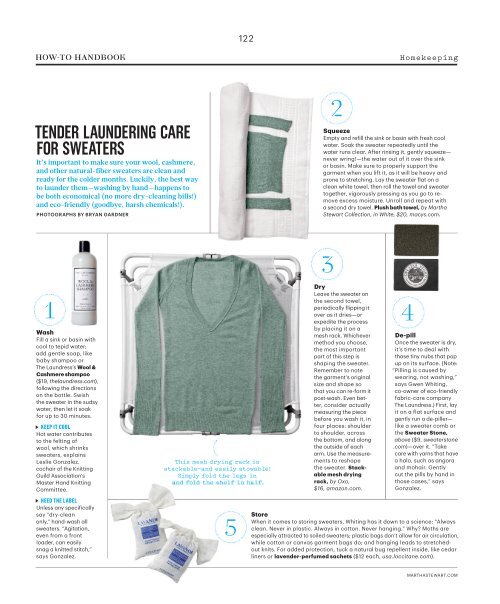MarthaStewartLivingOctober2015
You also want an ePaper? Increase the reach of your titles
YUMPU automatically turns print PDFs into web optimized ePapers that Google loves.
122<br />
HOW-TO HANDBOOK<br />
Homekeeping<br />
TENDER LAUNDERING CARE<br />
FOR SWEATERS<br />
It’s important to make sure your wool, cashmere,<br />
and other natural-fiber sweaters are clean and<br />
ready for the colder months. Luckily, the best way<br />
to launder them—washing by hand—happens to<br />
be both economical (no more dry-cleaning bills!)<br />
and eco-friendly (goodbye, harsh chemicals!).<br />
PHOTOGRAPHS BY BRYAN GARDNER<br />
2<br />
Squeeze<br />
Empty and refill the sink or basin with fresh cool<br />
water. Soak the sweater repeatedly until the<br />
water runs clear. After rinsing it, gently squeeze—<br />
never wring!—the water out of it over the sink<br />
or basin. Make sure to properly support the<br />
garment when you lift it, as it will be heavy and<br />
prone to stretching. Lay the sweater flat on a<br />
clean white towel, then roll the towel and sweater<br />
together, vigorously pressing as you go to remove<br />
excess moisture. Unroll and repeat with<br />
a second dry towel. Plush bath towel, by Martha<br />
Stewart Collection, in White, $20, macys.com.<br />
3<br />
1<br />
Wash<br />
Fill a sink or basin with<br />
cool to tepid water;<br />
add gentle soap, like<br />
baby shampoo or<br />
The Laundress’s Wool &<br />
Cashmere shampoo<br />
($19, thelaundress.com),<br />
following the directions<br />
on the bottle. Swish<br />
the sweater in the sudsy<br />
water, then let it soak<br />
for up to 30 minutes.<br />
KEEP IT COOL<br />
Hot water contributes<br />
to the felting of<br />
wool, which shrinks<br />
sweaters, explains<br />
Leslie Gonzalez,<br />
cochair of the Knitting<br />
Guild Association’s<br />
Master Hand Knitting<br />
Committee.<br />
HEED THE LABEL<br />
Unless any specifically<br />
say “dry-clean<br />
only,” hand-wash all<br />
sweaters. “Agitation,<br />
even from a front<br />
loader, can easily<br />
snag a knitted stitch,”<br />
says Gonzalez.<br />
This mesh drying rack is<br />
stackable—and easily stowable!<br />
Simply fold the legs in<br />
5<br />
Dry<br />
Leave the sweater on<br />
the second towel,<br />
periodically flipping it<br />
over as it dries—or<br />
expedite the process<br />
by placing it on a<br />
mesh rack. Whichever<br />
method you choose,<br />
the most important<br />
part of this step is<br />
shaping the sweater.<br />
Remember to note<br />
the garment’s original<br />
size and shape so<br />
that you can re-form it<br />
post-wash. Even better,<br />
consider actually<br />
measuring the piece<br />
before you wash it, in<br />
four places: shoulder<br />
to shoulder, across<br />
the bottom, and along<br />
the outside of each<br />
arm. Use the measurements<br />
to reshape<br />
the sweater. Stackable<br />
mesh drying<br />
rack, by Oxo,<br />
$16, amazon.com.<br />
4<br />
De-pill<br />
Once the sweater is dry,<br />
it’s time to deal with<br />
those tiny nubs that pop<br />
up on its surface. (Note:<br />
“Pilling is caused by<br />
wearing, not washing,”<br />
says Gwen Whiting,<br />
co-owner of eco-friendly<br />
fabric-care company<br />
The Laundress.) First, lay<br />
it on a flat surface and<br />
gently run a de-piller—<br />
like a sweater comb or<br />
the Sweater Stone,<br />
above ($9, sweaterstone<br />
.com)—over it. “Take<br />
care with yarns that have<br />
a halo, such as angora<br />
and mohair. Gently<br />
cut the pills by hand in<br />
those cases,” says<br />
Gonzalez.<br />
Store<br />
When it comes to storing sweaters, Whiting has it down to a science: “Always<br />
clean. Never in plastic. Always in cotton. Never hanging.” Why? Moths are<br />
especially attracted to soiled sweaters; plastic bags don’t allow for air circulation,<br />
while cotton or canvas garment bags do; and hanging leads to stretchedout<br />
knits. For added protection, tuck a natural bug repellent inside, like cedar<br />
liners or lavender-perfumed sachets ($12 each, usa.loccitane.com).<br />
MARTHASTEWART.COM
















